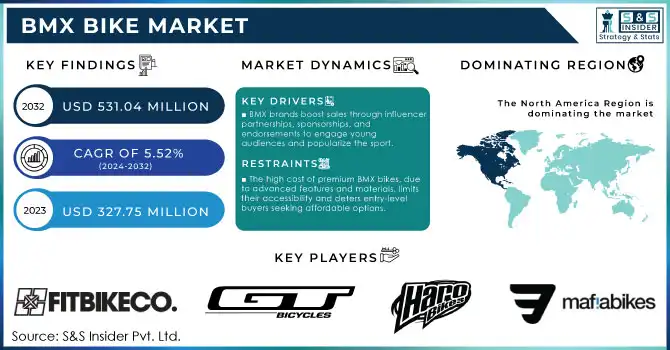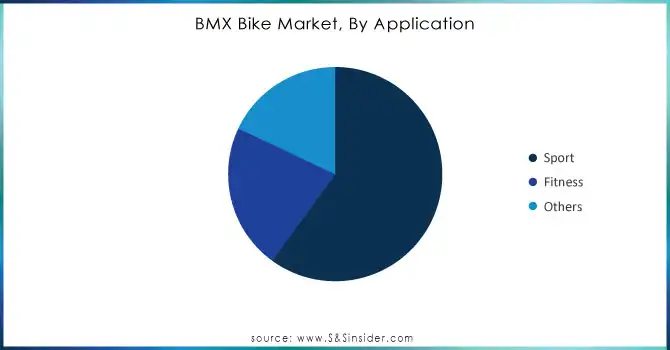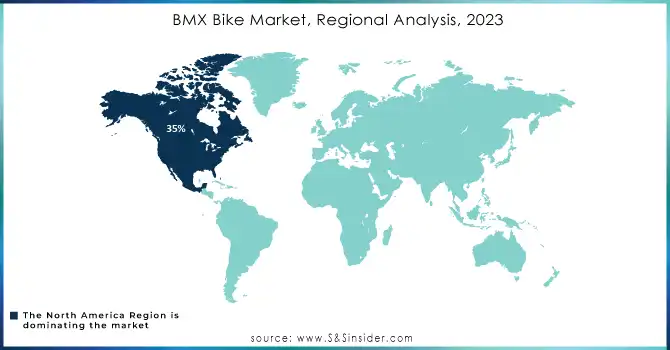BMX Bike Market Key Insights:

Get More Information on BMX Bike Market - Request Sample Report
The BMX Bike Market size was estimated at USD 327.75 Million in 2023 and is expected to reach USD 531.04 Million by 2032 at a CAGR of 5.52% during the forecast period of 2024-2032.
The BMX bike market has seen impressive growth, driven by increasing global interest in extreme sports, particularly among younger demographics. BMX biking, known for its unique mix of adrenaline-driven stunts, competitive events, and freestyle skills, has cultivated a dedicated following, which has propelled the market's expansion. The rise in BMX competitions at national and international levels, along with its inclusion in events like the Olympics, has further fueled this growth by enhancing the sport's visibility and attracting a broader audience. Additionally, the popularity of social media platforms, where BMX enthusiasts and influencers share high-energy, visually engaging content, has contributed to raising awareness and excitement around the sport. This online presence not only expands the sport’s fan base but also encourages new riders to adopt BMX biking as a recreational or fitness pursuit, which in turn boosts the demand for BMX bikes. The influence of digital media and an active online community, combined with high-profile sponsorships and endorsements from well-known brands, has solidified BMX biking’s status as a prominent extreme sport.
Furthermore, governments in various countries are increasingly investing in sports infrastructure, such as skate parks and bike parks, which has created more opportunities for BMX riders to practice and perform. These initiatives support community engagement in extreme sports, fostering an environment conducive to the growth of BMX biking. The market also benefits from advancements in bike materials and designs, catering to both recreational users and professional riders, which has broadened BMX's appeal across various skill levels. The BMX bike market is positioned for continued growth due to these influential factors, especially as the sport continues to capture a loyal, youthful audience that values active, adventurous lifestyle. The increased accessibility and promotion of BMX biking through competitive events, media coverage, and supportive infrastructure are expected to keep driving demand, with a robust market expansion forecasted in the coming years.
| Feature | Description | Commercial Products |
|---|---|---|
| Durability | Built to withstand rigorous use, shocks, and impacts, ensuring longevity under tough riding conditions. | Mongoose Legion L100, Redline Flight Pro BMX Bike |
| Lightweight Frame | Made from lightweight yet durable materials for optimal performance during tricks and stunts. | SE Racing Big Ripper, Diamondback Grind Pro |
| Enhanced Grip | Equipped with tires that provide better traction on ramps, dirt, and street surfaces. | Kenda Kontender BMX Tires, Odyssey Path Pro Tires |
| Adjustable Handlebars | Allows riders to customize the height and angle for comfort and control. | Sunday Bikes Pro Series, Fly Bikes Electron Bars |
| Impact Resistance | Designed to absorb high-impact forces from jumps and landings, preventing frame damage. | Fit Bike Co. Aitken Frame, Eastern Bikes Thor BMX |
| Customizable Components | Offers a range of customizable parts like wheels, pedals, and grips to suit individual rider needs. | S&M Bikes Holmes Complete, Haro Leucadia BMX Bike |
| Advanced Suspension | Features suspension systems that enhance stability and shock absorption during aggressive riding. | GT Pro Series Freestyle, BMX bikes with RST Dirt Fork |
| Aerodynamic Design | Optimized for high-speed racing with a streamlined frame that reduces air resistance. | Redline MX-24, Supercross BMX NSX Pro Frame |
| Safety Features | Includes safety measures like durable brake systems and reinforced handlebars for rider protection. | Shimano DXR Brake Kit, Tektro BMX Brakes |
| Versatility | Designed for both freestyle tricks and competitive racing, offering multi-terrain performance. | Kink BMX Complete Bikes, Specialized Fuse BMX Bike |
MARKET DYNAMICS
DRIVERS
-
Advancements in materials like carbon fiber and lightweight alloys, along with improved bike designs, are boosting BMX bikes' durability and performance, attracting new riders and driving market growth.
Innovation in BMX bike design and materials is propelling the market, driven by advancements in carbon fiber, lightweight alloys, and frame geometry. Carbon fiber, known for its strength-to-weight ratio, allows BMX bikes to withstand high-impact activities while remaining light enough for improved maneuverability. Likewise, lightweight alloys, such as aluminum and titanium, contribute to reduced weight, enhancing speed and ease of handling. These materials not only improve performance but also increase the lifespan of BMX bikes, making them more appealing to both new users and seasoned riders looking for upgrades. Additionally, innovations in frame design focus on optimizing ergonomics and control, giving riders an edge in competitive sports and extreme biking environments. More compact frame geometries improve balance and handling, appealing to BMX stunt riders and those engaged in high-stakes performances. This trend boosts demand as riders seeks the latest models to gain a competitive edge or improve their recreational experience.
The BMX bike market is experiencing robust growth, with increased participation in biking sports and an expanding consumer base, especially among younger demographics drawn to the adventurous appeal of BMX biking. The industry also benefits from a surge in bike-sharing programs and urban biking initiatives, fueling interest in BMX bikes for leisure and commuting purposes. These factors collectively drive market expansion, as technological advancements in materials and design continue to reshape consumer expectations and encourage both new purchases and model upgrades.
-
BMX brands boost sales by partnering with influencers and athletes to appeal to young audiences, using sponsorships and endorsements to enhance the sport's popularity.
Youth-oriented marketing and sponsorships play a crucial role in shaping the BMX bike market. BMX brands increasingly leverage partnerships with social media influencers and professional athletes, creating targeted promotions that resonate with younger audiences. These collaborations bring BMX culture to social media platforms, where it gains visibility among teenagers and young adults who are attracted to the sport’s dynamic and rebellious image. As a result, social media has become a powerful tool for brands to engage with a wider, more diverse audience that values authenticity and style, central themes in BMX culture.
Sponsorships and endorsements have a significant impact on the market by fueling the aspirational aspects of the sport. When prominent athletes endorse a particular BMX brand, it boosts the brand's credibility and appeal. This can lead to spikes in demand as young riders seek to emulate their favorite athletes, helping the market expand in tandem with increased participation in BMX sports. According to research, there’s been a steady rise in BMX sports’ global visibility due to high-profile competitions and BMX’s inclusion in major sports events, including the Olympics. Youth interest in extreme sports has surged by approximately 20% over the past five years, and the demand for BMX bikes reflects this trend. With sustained brand engagement, strategic sponsorships, and active promotion across social media, the BMX bike market continues to thrive, fueled by a vibrant youth culture that aligns with the sport's high-energy lifestyle.
RESTRAIN
-
The high cost of premium BMX bikes, due to advanced features and materials, limits their accessibility and deters entry-level buyers seeking affordable options.
The high cost of high-end BMX bikes is a significant restraint on the market. Premium BMX bikes, often made from advanced materials like carbon fiber or lightweight aluminum, come equipped with specialized features such as custom-built frames, top-tier suspension systems, and high-performance wheels. These bikes can cost several hundred to over a thousand dollars, making them unaffordable for many potential buyers, particularly those in the entry-level segment or those looking for more budget-friendly options. While these advanced models offer superior durability, speed, and handling, their high prices limit their accessibility to a broader audience, especially among younger or recreational riders who may not prioritize professional-level features.
The cost factor is especially pertinent in markets where consumers may already be hesitant to invest in niche sports equipment like BMX bikes. According to research, while cycling is popular, the most common price range for bikes purchased by individuals is between USD 400 and USD 700, which is well below the price point of high-end BMX bikes. This price disparity can create a gap between what is desired by enthusiasts and what is feasible for the average consumer, ultimately hindering the widespread adoption of premium BMX models. Additionally, this high price tag can affect the repeat purchase rate, as many riders may opt for more affordable models that still meet their recreational or beginner-level needs.
KEY SEGMENTATION ANALYSIS
By Application
The Sports segment dominated the market with 60% of market share in 2023 and is anticipated to maintain its lead in the coming years. This dominance is primarily driven by the extensive use of BMX bikes in bicycle motocross racing and off-road sports, which remain the core applications for these bikes. BMX racing, in particular, has gained significant traction globally, with more countries promoting competitive events and fostering youth participation. As the sport continues to grow in popularity, particularly in regions with emerging BMX cultures, the demand for high-performance bikes designed for racing and off-road activities is expected to rise. Additionally, the increasing interest in outdoor and adventure sports, coupled with rising awareness of the health benefits of cycling, further supports the segment's growth.

Need Any Customization Research On BMX Bike Market - Inquiry Now
By Distribution Channel
In 2023, the online segment dominated with over 37% of the market share. The growth of e-commerce and direct-to-consumer sales has significantly reshaped the way BMX bikes are sold. Online platforms offer brands a global reach, enabling them to tap into markets beyond their physical presence. Consumers increasingly prefer the convenience of shopping from home, where they can compare prices, explore a wide range of options, and read reviews before making a purchase. Additionally, online retailers often provide competitive pricing, promotions, and discounts that attract budget-conscious buyers. The ease of browsing through various brands and models from the comfort of one's home further boosts online sales, making it the leading distribution channel in the BMX bike market.
KEY REGIONAL ANALYSIS
In 2023, North America segment dominated the market with 35% of the market share, largely driven by strong consumer demand for outdoor recreational activities like cycling, paddle surfing, and bike riding, particularly in the U.S. and Canada. The region’s deep cultural affinity for cycling and its well-established outdoor sports infrastructure have been key contributors to this dominance. As more consumers embrace these activities, the demand for BMX bikes continues to rise, boosting market revenue. North America also benefits from a high level of disposable income, making it easier for consumers to invest in recreational equipment. This, combined with a growing trend of outdoor fitness and adventure sports, is expected to sustain and even expand BMX bike sales in the region.
Asia Pacific holds the largest market share in the BMX bike market and is expected to grow at the highest CAGR during the forecast period. This growth is driven by rising disposable incomes and the increasing popularity of BMX biking. Additionally, the region benefits from a youthful, active population, particularly in countries like China and India, where awareness of BMX biking is rising.

Key Players
-
Elite BMX (U.S.) – BMX frames, bikes, and components.
-
Fitbikeco (U.S.) – BMX bikes, frames, forks, handlebars, and parts.
-
G.T. Bicycle (U.S.) – BMX bikes, frames, and parts.
-
Haro Bicycle Corporation (U.S.) – BMX bikes, frames, handlebars, and accessories.
-
KINK BMX (U.S.) – BMX bikes, frames, parts, and accessories.
-
Mafiabike (U.K.) – BMX bikes, frames, and parts.
-
Pacific Cycle, Inc. (U.S.) – BMX bikes, frames, and parts.
-
Redline Bicycles (U.S.) – BMX bikes, frames, and components.
-
Stolen BMX (U.S.) – BMX bikes, frames, and parts.
-
Sunday Bikes (U.S.) – BMX bikes, frames, forks, and components.
-
DK Bicycles (U.S.) – BMX bikes, frames, handlebars, and accessories.
-
WeThePeople (Germany) – BMX bikes, frames, and parts.
-
Sunday Bikes (U.S.) – BMX bikes, components, and parts.
-
Subrosa Brand (U.S.) – BMX bikes, frames, wheels, and accessories.
-
Animal Bikes (U.S.) – BMX bikes, frames, parts, and accessories.
-
Trek Bicycle Corporation (U.S.) – BMX bikes and accessories.
-
Eastern Bikes (U.S.) – BMX bikes, frames, wheels, and accessories.
-
Cult BMX (U.S.) – BMX bikes, frames, and parts.
-
Se Bikes (U.S.) – BMX bikes, frames, and parts.
-
Felt Bicycles (U.S.) – BMX bikes and parts.
These suppliers supply BMX bikes and related components to riders around the world, catering to both entry-level enthusiasts and professional BMX riders of BMX Bike Market
-
Haro Bikes
-
Mongoose
-
GT Bicycles
-
Redline Bicycles
-
Kink BMX
-
DK Bicycles
-
WeThePeople
-
Fit Bike Co.
-
SE Bikes
-
Subrosa Brand
RECENT DEVELOPMENTS
In October 2023: Haro Bikes announced plans to bring a new line of electric BMX bikes to the North American market. The lineup will feature a variety of models, including freestyle, racing, and street-focused electric BMX bikes. With an emphasis on sustainability and performance, Haro Bikes aims to meet the rising demand for eco-friendly transportation options in urban areas.
In February 2024: Chimera BMX introduced an affordable steel version of its highly sought-after titanium e-BMX. The Los Angeles-based startup unveiled a hand-built, all-black steel 24" electric BMX, featuring a powerful 3800-watt motor, reaching top speeds of 35 mph, while maintaining a lightweight design of just 45 lbs.
In February 2024: Evolve Skateboards launched its first electric bike, Project BMX, in the U.K. Staying true to the BMX style, Evolve integrated the battery within the saddle and incorporated a Bafang M560 Mid Drive Motor into the frame. This innovative model blends electric technology with traditional BMX geometry, offering a distinct option for personal electric mobility.
| Report Attributes | Details |
|---|---|
| Market Size in 2023 | USD 327.75 Million |
| Market Size by 2032 | USD 531.04 Million |
| CAGR | CAGR of 5.52% From 2024 to 2032 |
| Base Year | 2023 |
| Forecast Period | 2024-2032 |
| Historical Data | 2020-2022 |
| Report Scope & Coverage | Market Size, Segments Analysis, Competitive Landscape, Regional Analysis, DROC & SWOT Analysis, Forecast Outlook |
| Key Segments | • By Application (Sport, Fitness, Others) • By Distribution Channel (Online, Offline) • By Top Tube Length (Less than 18 Inches, 18 - 20 Inches, 20 - 22 Inches, 22 Inches & Above) • By Category (Street, Dirt) |
| Regional Analysis/Coverage | North America (US, Canada, Mexico), Europe (Eastern Europe [Poland, Romania, Hungary, Turkey, Rest of Eastern Europe] Western Europe] Germany, France, UK, Italy, Spain, Netherlands, Switzerland, Austria, Rest of Western Europe]), Asia Pacific (China, India, Japan, South Korea, Vietnam, Singapore, Australia, Rest of Asia Pacific), Middle East & Africa (Middle East [UAE, Egypt, Saudi Arabia, Qatar, Rest of Middle East], Africa [Nigeria, South Africa, Rest of Africa], Latin America (Brazil, Argentina, Colombia, Rest of Latin America) |
| Company Profiles | Elite BMX (U.S.), Fitbikeco (U.S.), G.T. Bicycle (U.S.), Haro Bicycle Corporation (U.S.), KINK BMX (U.S.), Mafiabike (U.K.), Pacific Cycle, Inc. (U.S.), Redline Bicycles (U.S.), Stolen BMX (U.S.), Sunday Bikes (U.S.), DK Bicycles (U.S.), WeThePeople (Germany), Subrosa Brand (U.S.), Animal Bikes (U.S.), Trek Bicycle Corporation (U.S.), Eastern Bikes (U.S.), Cult BMX (U.S.), Se Bikes (U.S.), Felt Bicycles (U.S.). |
| Key Drivers | • BMX biking's inclusion in the Summer Olympics has boosted its global popularity, driving increased demand for bikes, particularly among youth and competitive athletes. • As health-conscious consumers increasingly prioritize physical activity, cycling, including BMX biking, is gaining popularity, particularly in urban areas as a recreational choice. |
| Restraints | • The high cost of premium BMX bikes, due to advanced features and materials, limits their accessibility and deters entry-level buyers seeking affordable options |

